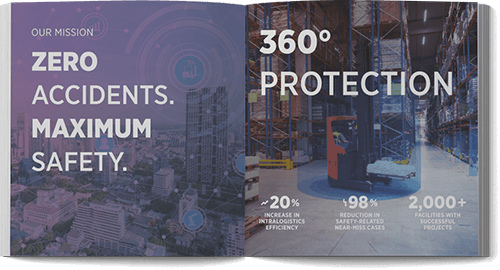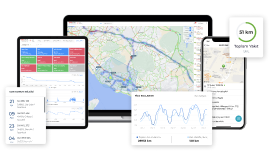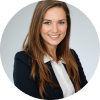Forklifts are used in many industries to carry, lift, or lower heavy materials such as pallets, boxes, and crates. They are one of the most frequently used pieces of equipment, providing time and labor efficiencies in the logistics industry enabling faster processes and more productive operations.
They are frequently used in multiple areas across businesses due to the benefits they provide, but keeping track of them can be problematic. Forklifts are often lost in large work areas such as warehouses or they are moved out of their normal place of use, meaning there is often not the right number of forklifts in the correct operational areas. This causes disruption to proceseses and leads to a decrease in efficiency in terms of workflow management.
Forklift Safety Systems System is offered as a solution to these problems. It has been developed as an application that enables real-time monitoring of forklifts with RTLS technology to determine their current location. Thanks to this system, the exact location of forklifts in the warehouse can be identified, their positions can be monitored in real-time, and reported from retrospectively to provide data for analysis. The system provides access to valuable insights on intralogistic processes which can then be used to inform operations and manage workflows without interruption.
In this article, we discuss what are benefits of the forklift safety system to logistics operations with IoT and RTLS technology.
How Does the System Work?
RTLS technology, called real-time location tracking, is a technology for tracking and managing assets or people as they move through a closed facility. By providing both real-time and detailed historical location and movement data, it provides businesses with 24/7 traceability within the warehouse. Although some technical standards and practices may differ, all RTLS platforms consist of the same basic hardware and software components.
Tracking: Tracking devices, also called location tags, are attached to forklifts and transmit identity and location data to receivers via a wireless signal. As forklifts with a location tag move, the tag sends signals to fixed sensors in the surrounding environment.
Receivers: RTLS receivers located around the facility receive signals from forklifts with tracking devices and pinpoint their location. Receivers can then see where these items are in real-time and transmit this to the platform used by the system.
Management platform: RTLS receivers send the location data they collect to a central management system. Facility officials use this central platform to analyze the data obtained to optimize their operational processes using a data-driven evidence approach. This platform can be customized and adapted to the needs of the user. As receivers collect data, and the platform makes that data available.
As a result of the sensors communicating in this way, the parameters that can be obtained are listed as follows:
- What are the routes followed by forklift operators?
- Which operators are getting speeding or pedestrian warnings?
- What are the most used routes?
- What are the most congested areas?
- Where and when do most accidents occur?
What are the Benefits of Forklift Safety System to Logistics Operations?
The logistics sector started to grow with a great acceleration with the increase of industrialization, causing an intense workflow in the internal logistics sector. In order to provide accident-free and efficient management of warehouses during this intense flow, forklifts and safety solutions have seen increasing popularity to enable greater monitoring and process optimization.
It is predicted that the forklift market will grow by 11.40% in the 2021-2028 forecast period.
An error in the logistics sector has a knock on effect on the business including a negative impact on time, money, and brand trust. It has become a necessity for operational processes to progress in a more controlled, problem-free, and efficient way. Warehouses are becoming increasingly dynamic environments, and for this reason, knowing where each forklift is located, and how much time it spends in each location can result in optimized use and invaluable data that provides high-income returns.
The effects of using the system in the logistics sector are as follows:
1. Optimization of operations and equipment
Thanks to the location information provided by RTLS technol, forklifts are prevented from leaving the factory area of use, and the fastest and safest routes of assets or workflow are created within the facility. In addition, the correct and necessary forklift numbers can be placed in the operation area of the facility, and task assignment and workflow management can be conducted in a more effective way according to this insight.
2. Efficiency
By providing real-time visibility of the forklifts, the location of each can be determined by checking an online platform instead of wasting time wandering around factories trying to find a particular forklift. Therefore, increasing efficiency and productivity levels.
At the same time, because warehouses are large areas, it is common for forklifts to get lost. This causes serious delays in the fulfillment of tasks. It also prevents such problems occurring.
3. Forklift Usage Periods
Effective time management is a very important issue in the logistics sector, and process delays and interruptions should be minimized as much as possible. With the tracking system, it is possible to see not only where and when a forklift is used, but also the frequency of use over time, using the data from the system to ensure optimal usage.
It can be observed how much a particular forklift is used in a day/week/month/year, it can be determined whether a forklift is not used enough or used too much, and action can be taken accordingly. It also helps managers evaluate whether there are too many forklifts onsite and whether they want to liquidate some of them.
4. Accident Prevention
As forklift accidents disrupt the logistics process and affect the facilities irreversibly, the tracking of forklifts also increases safety within the facility. Collisions are prevented with the use of Forklift Safety Systems, therefore a safer work environment is created for employees and business processes. The accident warning systems of forklifts make forklift management easy within the facility and maximize occupational health and safety standards.
If you want to digitize your logistics processes by keeping track of your forklifts and making your facility safer for both your employees and your equipment, you can visit our Trio Mobil Forklift Tracking and Safety page and contact us.








